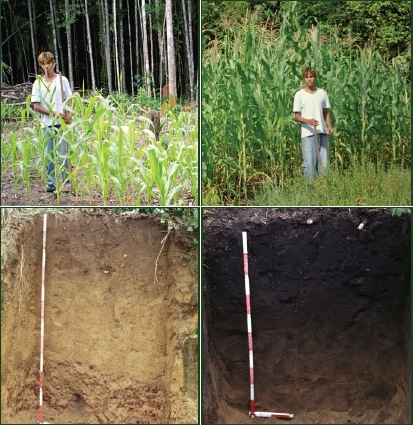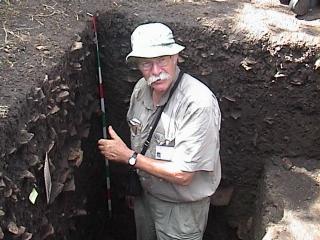Biochar History
The technique of using charcoal to improve the fertility of soils originated in the Amazon basin at least 2500 years ago. The native Indians of the region would create charcoal and incorporate it in small plots of land from 1 - 80 hectares in size. Terra Preta, as it is known in this area of Brazil, remains highly fertile until today, even with little or no application of fertilizers. And this is in a region of the world known for its highly infertile soils.
Ancient Sites
Terra Preta sites have been found mainly along the major rivers of the Amazon basin. 
These prehistorically modified soils of central Amazonia have been called a model for sustainable agriculture in the twenty-first century. The pictures show a section of soil 1 meter deep comparing Terra Preta on the right, with nearby Oxisol on the left of the type that is normally found in the Amazon basin.
Black is the New Green
The following is an extract from an article Black is the New Green (published in Nature Magazine). A full copy of this article can be downloaded here.
"The soil scientists, archaeologists, geographers, agronomists, and anthropologists who study terra preta now agree that the Amazon’s dark earths, terra preta do índio, were made by the river basin’s original human residents, who were much more numerous than formerly supposed. The darkest patches correspond to the middens of settlements and are cluttered with crescents of broken pottery. The larger patches were once agricultural areas that the farmers enriched with charred trash of all sorts. Some soils are thought to be 7,000 years old. Compared with the surrounding soil, terra preta can contain three times as much phosphorus and nitrogen. And as its colour indicates, it contains far more carbon. In samples taken in Brazil by William Woods, an expert in abandoned settlements at the University of Kansas in Lawrence, the terra preta was up to 9% carbon, compared with 0.5% for plain soil from places nearby. From Smith’s time onwards, the sparse scholarly discussion of terra preta was focused mainly on the question of whether ‘savages’ could have been so clever as to enhance their land’s fertility.
Since then trial after trial with crop after crop has shown how remarkably fertile the terra preta is. Bruno Glaser, of the University of Bayreuth, Germany, a sometime collaborator of Sombroek’s, estimates that productivity of crops in terra preta is twice that of crops grown in nearby soils. But it is easier to measure the effect than explain it through detailed analysis. Everyone agrees that the explanation lies in large part with the char (or biochar) that gives the soil its darkness. This char is made when organic matter smoulders in an oxygen-poor environment, rather than burns. The particles of char produced this way are somehow able to gather up nutrients and water that might otherwise be washed down below the reach of roots. They become homes for populations of microorganisms that turn the soil into that spongy, fragrant, dark material that gardeners everywhere love to plunge their hands into.  Wim Sombroek championed the study of the Amazon's dark soils.
Wim Sombroek championed the study of the Amazon's dark soils.
Leaving aside the subtleties of how char particles improve fertility, the sheer amount of carbon they can stash away is phenomenal. In 1992, Sombroek published his first work on the potential of terra preta as a tool for carbon sequestration. According to Glaser’s research, a hectare of metre-deep terra preta can contain 250 tonnes of carbon, as opposed to 100 tonnes in unimproved soils from similar parent material. The extra carbon is not just in the char — it’s also in the organic carbon and enhanced bacterial biomass that the char sustains."
